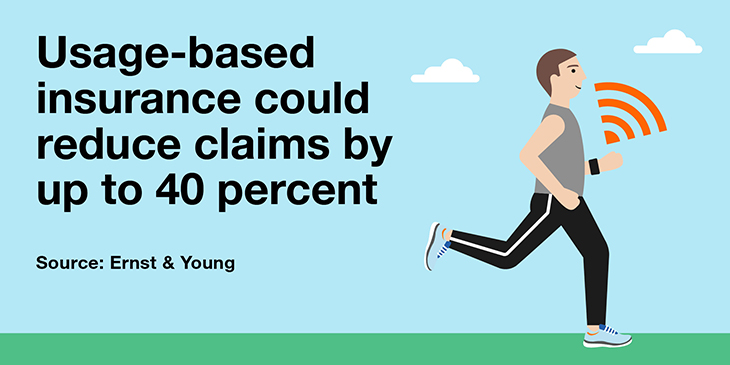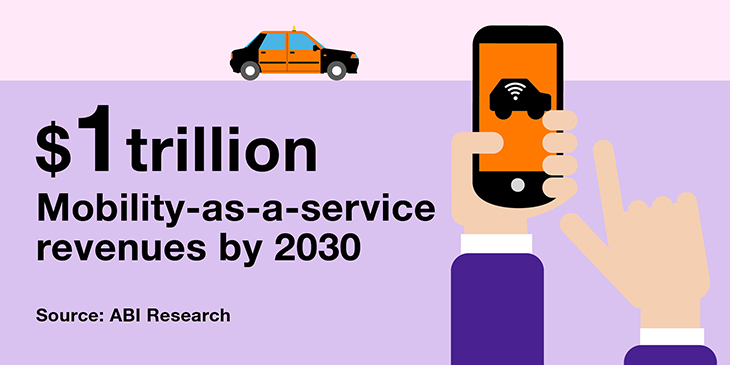Insurance companies are continually trying to categorize us based on our age and lifestyles to gauge risk and develop new products. The Internet of Things (IoT) will serve this information up on a plate, connecting assets and enabling the insurance industry to harvest customers’ data to deliver advanced and personalized insurance services.
IoT will be a game changer in the insurance sector, which up until now has been slow to change, thanks to laborious processes and a lack of available accurate data. “The amount of data produced by IoT devices is beginning to revolutionize the insurance sector,” explains Julien Masson, head of connected car at Orange Business. “It is opening up the market to personalized policies, while making insurance companies’ internal processes more streamlined and efficient.”
Auto insurance is likely to be the biggest beneficiary initially, according to Julien. Auto insurance policies, for example, have largely focused on vehicle models, demographics and postal codes, as it has been impossible to glean accurate data about individual driving behavior. Auto insurers are leading the way in adopting usage-based insurance (UBI) telematics programs to monitor how their customers drive, tailoring policies accordingly. Safer drivers are rewarded with lower insurance premiums. In the same way, home insurance companies are incentivizing policy holders who install water leak sensors.
With mobile taking over almost every aspect of our lives, it is no surprise that tech companies are moving insurance into apps. Brolly, an AI-driven insurance app, enables users to buy policies straight from the app and manage all their policies in one place to ensure they can keep track of what they are covered for and any claims they have or are making.
Usage-based insurance
In the auto sector, insurance companies are offering pay-how-you-drive (PHYD) or pay-as-you-drive (PAYD) policies, and health insurers are investigating wearables that could be linked to pay-as-you-live (PAYL) policies. Built on the same concept as automotive telematics, individuals could be offered attractive premiums based on healthy lifestyles.
According to research by Ernst & Young, UBI has the potential to reduce claims by up to 40 percent and policy administration by 50 percent, which could cut acquisition costs and allow policies to be priced more efficiently.

eCall, a European mandate designed to bring rapid assistance to motorists involved in a crash, has given telematics a boost. All new-build cars must be equipped with a telematics control unit that can make emergency calls. eCall is the first universal adoption of in-car telematics in Europe. “As a result, car makers are taking the opportunity to incorporate value-add services such as usage-based insurance,” explains Julien. The GSM Association predicts that by 2025 every new car will be connected in multiple ways.
UBI specialist Octo Telematics, for example, maintains it has analyzed approximately 186 billion miles of data from connected cars on roads, which is used to predict driver risk. The data can also be used by insurance companies after an accident to assess what happened and evaluate damage. This is faster and less expensive than sending out an insurance evaluator. As more insurance companies shift to a UBI model, fraudulent claims could also fall due to data tracking in real time.

Autonomous car insurance
Insurance companies must also brace themselves for change when it comes to self-drive cars and growth in mobility-as-a-service (MaaS), which will see a shift away from personally owned modes of transport to one that is consumed as a shared service.
MaaS has the potential to reduce congestion in cities by reducing people’s reliance on private vehicles. This reduction in overall vehicle numbers can also have a real impact on sustainability and reduce pollution levels. ABI Research forecasts that MaaS revenues will exceed $1 trillion by 2030.
Self-driving cars and MaaS are creating major questions for insurance companies that will need to be answered. At present, the consensus is that the manufacturer will be liable for damages if a self-drive car has an accident. With less accidents predicted as a result of self-drive cars and fewer cars on the road (because of MaaS), insurance companies will need to find new ways of analyzing data from connected cars to create new insurance models that are in step with the transport industry. Data insight will become more valuable than ever.
Orange Business, for example, is conducting live 5G connected car tests with Ericsson and the PSA Group at a site outside Paris to address connected vehicle requirements such as an intelligent transport system (ITS) to improve road safety and for in-car services. The partnership is technically focused on vehicle-to-vehicle (V2V) and vehicle-to-everything (V2X) architecture. At the same time, Orange Cyberdefense is looking at security issues surrounding IoT and telematics, ensuring that data is secure and easily and efficiently mineable.
Change is underway
Switched-on insurance companies will flourish in the age of the connected car, according to Julien. “They will be able to leverage the power of IoT and collaborate with car makers and service providers to better manage risk and provide services that are far more accessible to users,” he says. Other insurance sectors, such as home and health, will quickly follow.
Read about our solutions for the financial services industry and our connected car solutions for automotive.
